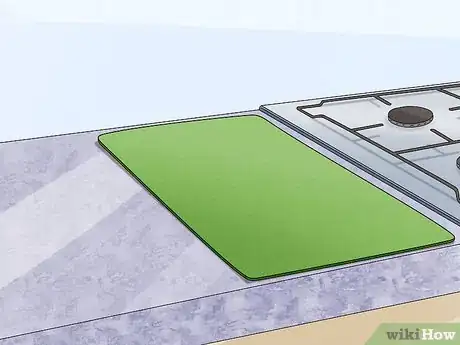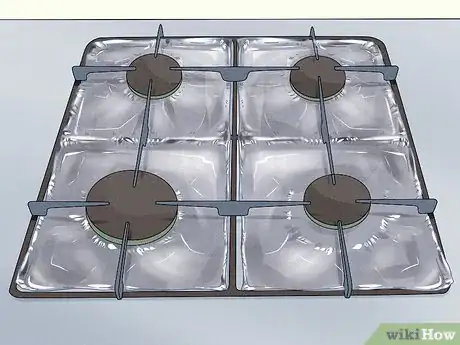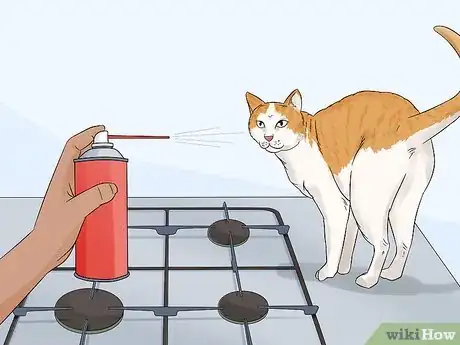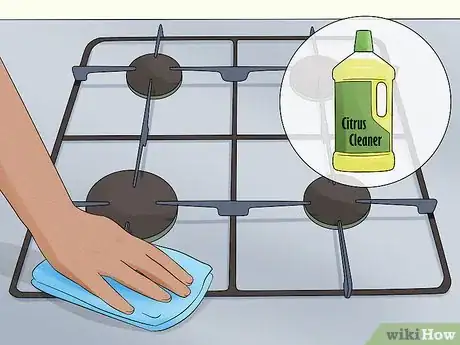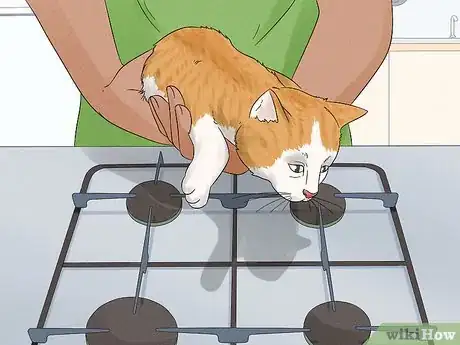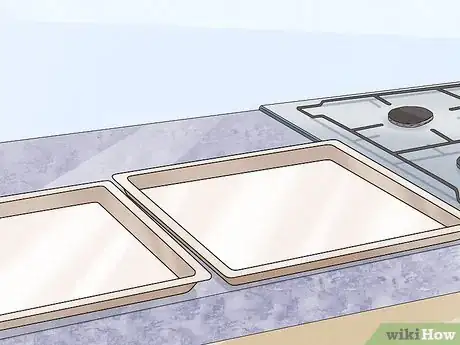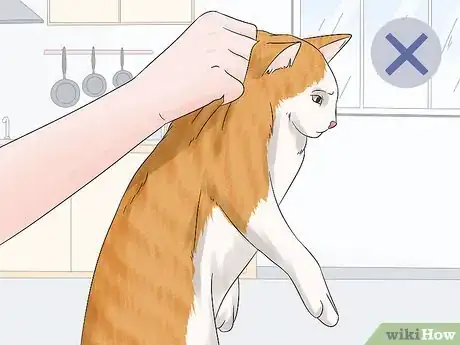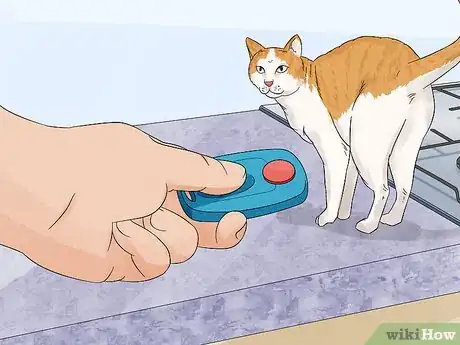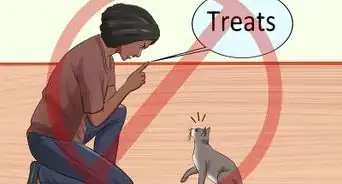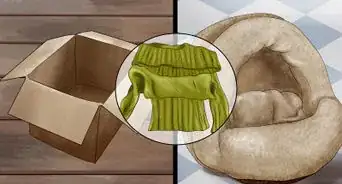This article was co-authored by Jessica Char and by wikiHow staff writer, Janice Tieperman. Jessica Char is a Cat and Dog Trainer, Behavior Consultant, and the Founder of Feline Engineering and Canine Engineering. She specializes in modifying challenging pet behavior problems, such as fear and aggression, using positive reinforcement training protocols. Jessica is a Certified Fear Free Trainer, a Certified Professional Dog Trainer, and a Certified Separation Anxiety Trainer. She is also a member of the International Association of Animal Behavior Consultants. Jessica received her BS and MS in Biomedical Engineering from Washington University in St. Louis.
There are 10 references cited in this article, which can be found at the bottom of the page.
This article has been viewed 30,183 times.
Curiosity won’t kill the cat, but it can lead to serious injury for your furry friend if they jump on a hot stove by accident. There’s no need to worry—cats are quick learners, and there are plenty of safe, harmless ways to convince your cat to be curious and playful in another part of your home. Experiment with different types of negative and positive enforcement, and see what resonates with your cat!
Steps
Easy Ways to Discourage Your Cat
-
1Discourage your cat with sticky placemats along the countertops.[1] Pick up a few plastic placemats from the store and cover a single side with strips of double-sided tape. Arrange these sticky placemats along the edge of the kitchen counter near your stove, or wherever your cat typically leaps to. Cats really hate the sticky feeling of tape beneath their paws, which makes this option effective.[2]
- Once your cat breaks their bad counter- and stove-surfing habit, you can remove the placemats from your kitchen.
-
2Cover parts of your countertop with aluminum foil or bubble wrap.[3] Keep an eye out for your cat’s reaction as they jump on these surfaces. For some reason, cats hate the feeling of foil or bubble wrap, and may learn not to jump near the stove this way.[4]Advertisement
-
3Deter your cat with compressed air. Spray your cat a spritz of compressed air whenever they jump on the stove-top or nearby countertops. Only squirt the air around their back and chest—don’t spray it near their eyes or nose, which are pretty sensitive. Don’t let your cat see you squirt them—you want them to think that the gust of air came out of nowhere, not from you.[5]
-
4Wipe down your countertops and stove with a citrus cleaner. Pick up a pet-friendly citrus cleaning spray that you can spritz near your countertops and stove area. Cats aren’t a fan of this scent, and the smell may keep them away from your stove. Plus, it’ll help you keep your kitchen clean![8]
- Double-check the label to make sure the cleaning spray is safe for pets. You might have more luck finding a safe spray at a pet store.
- Cats also aren’t a big fan of citronella, aloe, wintergreen, or eucalyptus scents.[9]
-
5
-
6Block common landing areas on the countertop. Keep an eye on your cat throughout the week, studying where they tend to leap on the counter and stove. Move items around on your counter so these landing spaces are blocked off.[14]
- For instance, if you keep your spices on the countertop, move these around near your stove, so your cat can’t jump up onto that area.
-
7Startle your cat with precarious cookie sheets. Arrange cookie sheets along the edge of the countertop, with 1 side partially dangling off. As your cat jumps onto the counter, they’ll actually land on the cookie sheet, which will fall and make a clanging noise. This may give your cat a bad association with counter-surfing, and keep your cat off the stove in the future.[15]
-
8Don’t punish your cat for jumping on the stove. Counter- and stove-surfing are definitely annoying, but obvious punishments, like shouting at your pet, won’t accomplish anything except make your furry friend extra nervous and possibly afraid of you.[16] Additionally, never push your cat off the stove or counter, or else your furry friend might get hurt by accident. Instead, look into subtle ways to convince your cat to hang out in another part of your home.[17]
- Some cats will lash out when punished, and try to bite you or refuse to use their litter boxes.[18]
EXPERT TIPJessica Char is a Cat and Dog Trainer, Behavior Consultant, and the Founder of Feline Engineering and Canine Engineering. She specializes in modifying challenging pet behavior problems, such as fear and aggression, using positive reinforcement training protocols. Jessica is a Certified Fear Free Trainer, a Certified Professional Dog Trainer, and a Certified Separation Anxiety Trainer. She is also a member of the International Association of Animal Behavior Consultants. Jessica received her BS and MS in Biomedical Engineering from Washington University in St. Louis.Cat & Dog Behavior Consultant
 Jessica Char
Jessica Char
Cat & Dog Behavior ConsultantInstead of punishing your cat, treat the underlying issue. Look for a way to give your cat the same thing he looks for in the stove. If he wants to stay warm, give him a cozy place to be. If he wants attention, reward him with attention in another spot of the house. You can also add something uncomfortable over the stove to keep the cat away from it and redirect him to other options.
Encouragements and Rewards
-
1Put out cat trees and pieces of furniture your cat can jump on. Cats love to climb to high places, which is why they enjoy leaping on countertops and stoves in the first place. Keep your pets entertained by giving them plenty of safe places to climb, like cat trees.[19] You can also set up furniture in a separate room that’s safe for your cat to climb and explore, like a bookshelf.[20]
- If your cat is distracted with fun, safe climbing areas, they might not spend as much time near your stove.
- Place your cat tree near a window so your cat can see outside.[21]
-
2Spend time with your cat each day so they don’t feel ignored. Cats sometimes counter-surf because they’re looking for attention. Carve some time out of your day to give your furry friend a little extra TLC—this may help satisfy your cat’s need for attention, and keep them from jumping onto the stove when you’re in the kitchen.[22]
-
3
-
4Encourage your cat to stay off the counter or stove with a clicker.[25] Pay attention to whenever your cat jumps off the stovetop or nearby counter. Place your cat’s favorite treat on the ground, and click a special cat clicker right as your furry friend eats the treat. Repeat this process whenever your cat hops on the stove—eventually, they’ll associate the sound of the clicker with tasty treats![26]
- You can find pet clickers online, or at pet supply stores.
Expert Q&A
-
QuestionWhy does my cat lay on the stove?
 Jessica CharJessica Char is a Cat and Dog Trainer, Behavior Consultant, and the Founder of Feline Engineering and Canine Engineering. She specializes in modifying challenging pet behavior problems, such as fear and aggression, using positive reinforcement training protocols. Jessica is a Certified Fear Free Trainer, a Certified Professional Dog Trainer, and a Certified Separation Anxiety Trainer. She is also a member of the International Association of Animal Behavior Consultants. Jessica received her BS and MS in Biomedical Engineering from Washington University in St. Louis.
Jessica CharJessica Char is a Cat and Dog Trainer, Behavior Consultant, and the Founder of Feline Engineering and Canine Engineering. She specializes in modifying challenging pet behavior problems, such as fear and aggression, using positive reinforcement training protocols. Jessica is a Certified Fear Free Trainer, a Certified Professional Dog Trainer, and a Certified Separation Anxiety Trainer. She is also a member of the International Association of Animal Behavior Consultants. Jessica received her BS and MS in Biomedical Engineering from Washington University in St. Louis.
Cat & Dog Behavior Consultant You need to identify what your cat gains from staying on the stove. Maybe you give him attention or treats, for example.
You need to identify what your cat gains from staying on the stove. Maybe you give him attention or treats, for example.
Warnings
- Never use negative reinforcement that could physically hurt your cat. Your main and only goal is to discourage your cat, not to scare or hurt it.[30]⧼thumbs_response⧽
Things You’ll Need
Easy Ways to Discourage Your Cat
- Double-sided tape
- Placemats
- Aluminum foil or sticky tape
- Compressed air
- Citrus-scented cleaning products
- Cookie sheets
Encouragements and Rewards
- Cat tree
- Cat goodies
- Cat treat dispenser
- Clicker
References
- ↑ Jessica Char. Cat & Dog Behavior Consultant. Expert Interview. 28 September 2021.
- ↑ https://www.animalhumanesociety.org/behavior/keeping-your-cat-counter
- ↑ Jessica Char. Cat & Dog Behavior Consultant. Expert Interview. 28 September 2021.
- ↑ https://www.hshv.org/keeping-cats-off-of-countertops/
- ↑ https://www.easternanimalhospital.com/care-guides/cat-care/keep-cat-off-tables-counters/
- ↑ https://www.petsafe.net/media/manuals/400-2114.pdf
- ↑ Rita Reimers. Cat Behaviorist. Expert Interview. 22 June 2021.
- ↑ https://www.easternanimalhospital.com/care-guides/cat-care/keep-cat-off-tables-counters/
- ↑ https://www.mspca.org/pet_resources/correcting-unwanted-cat-behavior/
- ↑ https://www.easternanimalhospital.com/care-guides/cat-care/keep-cat-off-tables-counters/
- ↑ Rita Reimers. Cat Behaviorist. Expert Interview. 22 June 2021.
- ↑ Rita Reimers. Cat Behaviorist. Expert Interview. 22 June 2021.
- ↑ Rita Reimers. Cat Behaviorist. Expert Interview. 22 June 2021.
- ↑ https://www.pdsa.org.uk/taking-care-of-your-pet/looking-after-your-pet/kittens-cats/how-to-stop-cats-jumping
- ↑ https://www.hshv.org/keeping-cats-off-of-countertops/
- ↑ https://www.animalhumanesociety.org/behavior/keeping-your-cat-counter
- ↑ https://www.easternanimalhospital.com/care-guides/cat-care/keep-cat-off-tables-counters/
- ↑ https://www.animalhumanesociety.org/behavior/keeping-your-cat-counter
- ↑ Jessica Char. Cat & Dog Behavior Consultant. Expert Interview. 28 September 2021.
- ↑ https://www.pdsa.org.uk/taking-care-of-your-pet/looking-after-your-pet/kittens-cats/how-to-stop-cats-jumping
- ↑ https://www.petmd.com/cat/behavior/how-get-your-cat-stay-kitchen-counter
- ↑ https://www.animalhumanesociety.org/behavior/keeping-your-cat-counter
- ↑ Jessica Char. Cat & Dog Behavior Consultant. Expert Interview. 28 September 2021.
- ↑ https://www.animalhumanesociety.org/behavior/keeping-your-cat-counter
- ↑ Jessica Char. Cat & Dog Behavior Consultant. Expert Interview. 28 September 2021.
- ↑ https://broadviewuniversity.edu/2018/10/05/cat-training-tips-vet-tech-guide/
- ↑ https://www.animalhumanesociety.org/behavior/keeping-your-cat-counter
- ↑ https://www.animalhumanesociety.org/behavior/keeping-your-cat-counter
- ↑ https://www.easternanimalhospital.com/care-guides/cat-care/keep-cat-off-tables-counters/
- ↑ https://www.easternanimalhospital.com/care-guides/cat-care/keep-cat-off-tables-counters/
